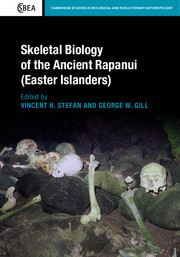Book contents
- Frontmatter
- Contents
- List of contributors
- Acknowledgements
- 1 Introduction: Research overview
- 2 Review of Polynesian and Pacific skeletal biology
- 3 Chronology and Easter Island prehistory
- 4 A descriptive skeletal biology analysis of the ancient Easter Island population
- 5 Craniometric variation of the prehistoric Polynesians and Rapanui
- 6 Rapanui non-metric cranial traits
- 7 Intra-island discrete cranial trait variation
- 8 Continuous non-metric characteristics of the early Rapanui
- 9 Rapanui dental morphology
- 10 Pelvic variability and sexual dimorphism in prehistoric Rapanui
- 11 Genetic affinities of the Rapanui
- 12 Archaeogenetics and paleodemographic estimation of founding populations: Features of residential geography on Rapa Nui
- 13 Evidence for injuries and violent death
- 14 Demographic analysis of modified crania from Rapa Nui
- 15 East Polynesian and Paleoindian parallels and contrasts in skeletal morphology
- 16 Rapanui origins, relationships, and warfare: A summary in theoretical context
- References
- Index
13 - Evidence for injuries and violent death
Published online by Cambridge University Press: 05 December 2015
- Frontmatter
- Contents
- List of contributors
- Acknowledgements
- 1 Introduction: Research overview
- 2 Review of Polynesian and Pacific skeletal biology
- 3 Chronology and Easter Island prehistory
- 4 A descriptive skeletal biology analysis of the ancient Easter Island population
- 5 Craniometric variation of the prehistoric Polynesians and Rapanui
- 6 Rapanui non-metric cranial traits
- 7 Intra-island discrete cranial trait variation
- 8 Continuous non-metric characteristics of the early Rapanui
- 9 Rapanui dental morphology
- 10 Pelvic variability and sexual dimorphism in prehistoric Rapanui
- 11 Genetic affinities of the Rapanui
- 12 Archaeogenetics and paleodemographic estimation of founding populations: Features of residential geography on Rapa Nui
- 13 Evidence for injuries and violent death
- 14 Demographic analysis of modified crania from Rapa Nui
- 15 East Polynesian and Paleoindian parallels and contrasts in skeletal morphology
- 16 Rapanui origins, relationships, and warfare: A summary in theoretical context
- References
- Index
Summary
Introduction
Based on oral traditions, Rapa Nui is often portrayed as having a history of warfare and violence (Métraux, 1940; Routledge, 1919; Thomson, 1891) and a frequently cited hypothesis of societal collapse culminating in civil war (Diamond, 1995, 2005, 2007). There are, however, arguments against intertribal conflict resulting from such a decline (Hunt, 2007; Hunt and Lipo, 2009; Hunt and Lipo, 2011). While other types of data can be presented, direct evidence for both the presence and nature of past violence is marked on human skeletal remains. Previous analyses of injuries (Gill and Owsley, 1993; Owsley et al., 1994) determined that a relatively small percentage of Rapanui remains showed evidence of traumatic death. The current study revisits this topic among the prehistoric and historic Rapanui, using an expanded sample to assess physical evidence for injuries in the skull and limbs. The objective is to gain more definitive information about violence and warfare as factors related to the collapse of the society.
Easter Island warfare
Literature exploring and debating societal decline and collapse on Rapa Nui is extensive. Violence is a common theme in oral traditions recorded by late nineteenth- and early twentieth-century visitors. Among other legends in which conflict and cannibalism are prominent, a tribal war between the “Long Ears” and the “Short Ears” is described (Métraux, 1940; Routledge, 1919; Thomson, 1891). Multiple versions of this story exist, and while the details differ, the rivalry between the two groups results in the near-extermination of the Long Ears by the Short Ears. This event was dated to AD 1680 by Father Sebastián Englert (1948), based on his chronology of Rapa Nui and genealogical history (Lipo and Hunt, 2009). In 1956, the Norwegian Archaeological Expedition research team radiocarbon dated Poike Ditch, the location where most of the Long Ears were reportedly burned to death, to approximately AD 1676 (Smith, 1961a: 391). With reinforcement from this single radiocarbon date, AD 1680 became associated with a climactic event in Rapa Nui chronology that was used to delineate the Middle Period (ca. AD 1100–1680) from the Late Period (AD 1680–1868) (Lipo and Hunt, 2009; Smith, 1961a: 391, 1961b: 395).
- Type
- Chapter
- Information
- Skeletal Biology of the Ancient Rapanui (Easter Islanders) , pp. 222 - 252Publisher: Cambridge University PressPrint publication year: 2016
- 6
- Cited by



